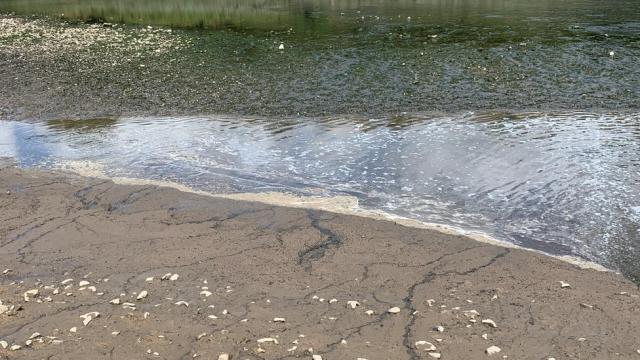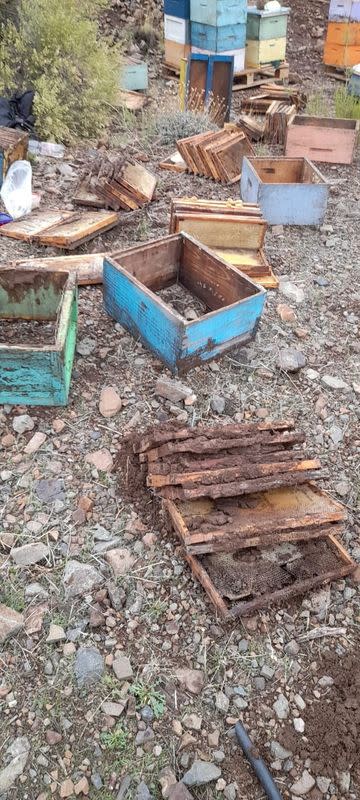Science Daily News | 29 Jun 2023

Views (136)

Crowds turn out for Royal Norfolk Show
About 85,000 people are due to visit one of the UK's largest county shows over the next two days.

About 85,000 people are expected to turn out to one of the UK's largest county show over the next two days.
The Royal Norfolk Show is under way at the Costessey showground on the edge of Norwich.
Aside from prize-winning animals, choirmaster and broadcaster Gareth Malone will lead 3,000 children from the county in a Virtual Grand Sing.
"It is a celebration of Norfolk over the next two days," said show director Mark Nicholas.
"Norfolk has been the hotbed of agricultural innovation and revolutions through organisations such as the Norwich Research Park's plant-based science, but also through the county's farmers who really need to be put on a pedestal in the course of the show," he added.
Highlights from this year's programme include displays by the RAF Falcons parachute team, a motorcycle stunt team and a Shetland Pony derby.
Crowds returned to the site last year for the first time since 2019 following its hiatus due to Covid.
The Princess Royal was last year's special guest, with this year's royal visitor yet to be announced.
The agricultural showpiece will feature about 3,000 animals and 700 trade exhibitors.
Supermassive black holes grow surprisingly quickly, study suggests
A new way to estimate the masses of supermassive black holes suggests that these cosmic titans may grow faster than previously believed.

There were more monstrous black holes in the early universe than previously thought, a new study suggests.
There are several theories about how supermassive black holes grow to incredible sizes, most of which involve the mergers of smaller black holes.
But there's a problem with this idea: Has there been enough time in the 13.8-billion-year history of the universe for these processes to grow supermassive black holes so big, especially the ones that existed billions of years ago?
"There's been the expectation that you would only see these really massive systems in the nearby universe," Simon said. "It takes time for black holes to grow."
RELATED STORIES:
The new research suggests that these monstrous supermassive black holes may not need as much time to grow as previously theorized. Similar conclusions have been reached by astronomers who have spotted unexpectedly large black holes lurking in the early universe.
In the next steps for this research, Simon intends to investigate black holes located even farther away from Earth and thus seen even earlier in cosmic history. He hopes that this investigation could help reveal how galaxies like the Milky Way form, given that supermassive black holes exert a tremendous influence over the galaxies that host them.
"Understanding the masses of black holes is critical to some of these foundational questions like the gravitational wave background, but also how galaxies grow and how our universe has evolved," he concluded.
River pollution: Warning Western Cleddau faces ecological disaster
The river regulator says it is aware of "multiple concerns" and it is investigating.

Campaigners want action amid warnings that a river in Pembrokeshire faces "ecological disaster" due to pollution.
Video shows discoloured liquid released into the Western Cleddau from two discharge pipes and a thick residue on the riverbank, which campaigners claim is from a First Milk discharge pipe.
Regulator Natural Resources Wales (NRW) said it was investigating.
First Milk said "discoloured discharge" had been released for a short time, but was within limits set by NRW.
The company, which operates one of the two outfall pipes, said the discharge went into the water from its treatment facility at Merlin's Bridge earlier this month.
Campaigners dispute the claim that this was an isolated incident.
Welsh Water said its waste treatment facility at Merlin's Bridge "temporarily experienced operational issues" after an "unauthorised dairy-type product" was placed into the sewer network. It said the matter was now resolved, although it was investigating the source.
Simon Walters has lived near the Western Cleddau all his life, but started documenting discharges over the past few weeks because of his mounting concerns.
One of the outfall pipes at the Fortune's Frolic site is connected to the First Milk cheese creamery in Haverfordwest. The other pipe is connected to the local Welsh Water waste water treatment works.
Mr Walters claimed the river was facing disaster.
"I've seen it being decimated over the years," he said.
"Fish numbers have fallen off a cliff. Bird life has disappeared. The [discharge from the] sewage pipe can be very dark and grey and fluctuating in volumes.
"The First Milk pipe has been in full flow for two, three or four hours at a time with brown effluent, and this has been going on for months."
Mr Walters claimed the discharges from the First Milk pipe had "coated" the banks of the river with a "red, orangey mousse" which turned black as it dried out.
First Milk said it had a "small issue" with its treatment facility which resulted in "some discoloured discharge" being released into the river for "a short time" which was "rapidly addressed".
The company claimed that the incident "did not breach the discharge consents set by NRW, or represent a significant risk to the environment".
Gail Davies-Walsh, chief executive of Afonydd Cymru, the Wales river trusts umbrella body, said she agreed with campaigners that the Western Cleddau was on the brink of disaster and called on NRW to review consents for discharges into the river.
She also claimed there was evidence of more long-standing concerns at the First Milk site.
"It was originally picked up for nutrient failures in 2005/6," she said.
"Measures were taken against those. More recently, there's clear evidence of failure against some of the conditions on their permits and that has been over multiple years."
In response, First Milk said it had recently conducted a "full operational review" of its treatment works and had appointed a "new operator to run and manage the facility" in conjunction with the company. It also said it was making further investment in its treatment facility.
Ms Davies-Walsh said there should be "stricter regulation and enforcement" by NRW.
Stephen Esmond, secretary of the Pembrokeshire Anglers Association, said: "Sea trout numbers have fallen off a cliff.
"My concerns were raised a few weeks ago about how much stuff is coming out of here. I think the fish are coming up here and are tasting this foul material and not making their way up the river.
"We haven't seen any fresh fish come for about a month. This isn't as diluted, so it's a stronger mixture, putting the fish off. There should be shoals and shoals of bass and all we've seen are mullet. Mullet like this sort of environment, but there's no bass."
Mr Esmond, who said club membership was down because of declining fish stocks, also called for better policing of the rivers by NRW.
"Get NRW down here more often to keep an eye on it," he said. "Get the locals who are on hand so they can be here. A heavy discharge can go on for three or four hours. It's lifeless here."
Ric Cooper, a scientist from Hook, is also a kayaker and paddle boarder on the river, and has been gathering information about its water quality.
"I've been asking NRW and other agencies for analytical data on the river," said Mr Cooper.
"It's pretty clear that the nitrogen levels in this river - the nitrate levels - are much higher than they should be. This river is hypernutrified which means there is too much phosphorus and nitrogen in it.
"You get overgrowth of algae that soak up the oxygen and these nutrients and you get a decrease in the oxygen available to the fish and the invertebrates in the mud, with the all the knock-on effects."
In January 2021, a report for NRW concluded that the Western Cleddau was failing its phosphorus targets "in every water body" that was assessed.
It was recommended that a special project be initiated on the Cleddau rivers to reduce phosphorus concentrations in the river, with particular focus on the Western Cleddau.
Mars rover Perseverance sets new record for making oxygen on Red Planet
Earlier this month, the MOXIE oxygen-making experiment on the Perseverance Mars rover achieved a major milestone.

GOLDEN, Colorado - Breathe easy: There's good news from Mars.
Earlier this month, the experiment achieved a major milestone when researchers pushed MOXIE to a maximum production level — a factor of two higher than reached earlier.
"We got great results," said Michael Hecht, MOXIE's principal investigator and an associate director of the Massachusetts Institute of Technology's (MIT) Haystack Observatory in Westford, Massachusetts.
"This was the riskiest run we've done," Hecht told Space.com in an exclusive interview. "This could have gone wrong," he said, and could have led to minor damage to the instrument, but it didn't. The milestone setting Mars run took place on June 6, operating during the Martian night, and lasted 58 minutes, Hecht said.
The requirements for MOXIE were to produce 6 grams of oxygen an hour, a rate that was eventually doubled. "We rolled the dice a little bit. It was 'hold your breath and see what happens,'" Hecht said.
The challenge all along, Hecht added, has been to define ways to operate on Mars more efficiently by cranking out a higher yield of oxygen.
Hecht presented a review of MOXIE, detailing a Martian year of on-the-spot resource utilization on the Red Planet at the 23rd meeting of the Space Resources Roundtable, held June 6-9 at the Colorado School of Mines.
MOXIE weighs roughly 40 pounds (18 kg) and is designed to pull in Martian air using a pump before using an electrochemical process to separate one oxygen atom from each molecule of carbon dioxide. As a byproduct, carbon monoxide is produced, as is a black residue of solid carbon that can gum up the works inside the device, Hecht said. So voltage vigilance is required as MOXIE performs its high-temperature, oxygen-making work, he added.
In 2022, MOXIE technologists focused more on pushing the unit's capabilities, as well as developing new operating modes. All in all, the earlier start-stop set of 14 runs added up to 1,000 minutes of operating time. "It's been an exciting ride," Hecht told the Colorado School of Mines audience.
But MOXIE is a technology demonstration, and like many other demonstrators, its long-term life is tied to funding. Research money for MOXIE is set to end at year's end, Hecht said, with the MIT lab that carries out the work on the lookout for new collaborations.
RELATED STORIES:
Understanding just how far MOXIE can be pushed before it degrades is important. "On Mars you don't get a second chance," Hecht told Space.com. "We could turn it on at 12 grams an hour and let it rip for a long time."
Perhaps there is value in coming back in a year, Hecht observed, to turn the experiment on again to see if anything has degraded just from aging and exposure to the Martian environment.
"MOXIE isn't going anywhere being nice and safe on Mars," Hecht said.
Chile's bee colonies devastated by floods after fires
Extreme weather events in Chile, including major recent floods and wildfires earlier this year, are devastating colonies of the humble bee, a key pollinator for crops of avocados and almonds in one of the global south's key food producing countries. "We were affected by the fires and now the floods," said Mario Flores, president of the National Beekeeping Movement (Monachi), adding that over 3,000 beehives were affected last week alone in heavy rains in Chile's south-central region. "The situation we are experiencing today is critical for the national beekeeping industry."

SANTIAGO (Reuters) - Extreme weather events in Chile, including major recent floods and wildfires earlier this year, are devastating colonies of the humble bee, a key pollinator for crops of avocados and almonds in one of the global south's key food producing countries.
Heavy rainfall in the last week has caused floods that have blocked off roads and prompted evacuations in the center of the country in what has been described as the worst weather front in a decade. That follows major fires at the start of the year.
"We were affected by the fires and now the floods," said Mario Flores, president of the National Beekeeping Movement (Monachi), adding that over 3,000 beehives were affected last week alone in heavy rains in Chile's south-central region.
"The situation we are experiencing today is critical for the national beekeeping industry."
Chile's bee population, hit hard in recent years by drought, is important for pollinating many of the South American country's export crops including cherries, blueberries and apples, part of a multi-billion dollar food industry.
Losses have mounted during recent floods, beekeeper Carlos Nunez said, with 300 of his 500 hives ruined last week after the Cachapoal River broke its banks in a province to the south of capital Santiago.
"It was a total loss. What was saved we are going to see if it can be recovered," he said. "Everything is lost."
The government has decreed an agricultural emergency in areas affected by the floods to financially help farmers, particularly from Santiago to the southern Biobio region.
"Whatever (help) we get will be welcome because we have been having problems in the beekeeping sector for a long time now, with the fires in the summer, the honey exportation, the fake honey competition," said Nunez.
"We are trying to keep our heads up and whatever help we can get will be good."
(Reporting by Reuters TV; Writing by Natalia Ramos and Carolina Pulice; Editing by Isabel Woodford and David Gregorio)
NASA wants ideas for Artemis 3 moon landing experiments. But time's running out.
NASA is soliciting the scientific community for ideas about instruments and experiments that could accompany Artemis 3 astronauts on their mission to the moon.

NASA is soliciting the scientific community for ideas about instruments and experiments that could accompany Artemis 3 astronauts on their mission to the moon.
In soliciting proposed experiments for Artemis 3 astronauts to deploy on the moon's surface, NASA spelled out several other experimental goals that it says will be given priority for consideration. These include:
Understanding planetary processes
Understanding the character and origin of lunar polar volatiles
Interpreting the impact history of the Earth-moon system
Revealing the record of the ancient sun and our astronomical environment
Observing the universe and the local space environment from a unique location
Conducting experimental science in the lunar environment
Investigating and mitigating exploration risks
"These science packages will enable a variety of geophysical and environmental investigations," the agency wrote in its posting announcing the solicitation. "In addition to their intrinsic science value, some measurements from deployed instruments may also reduce risks to astronauts."
RELATED STORIES:
And who knows? Making a baking soda and vinegar volcano on the moon might not be as silly an idea as you might think. Just make sure you read the instructions on NASA's program site for all the pertinent details first.
0 Likes
